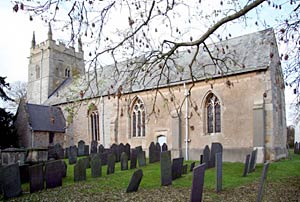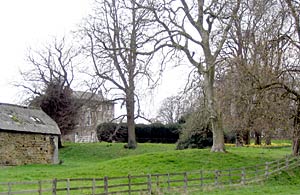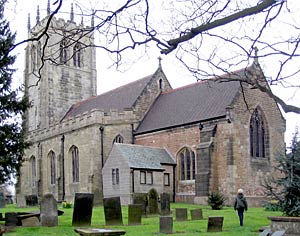< Previous | Contents | Next >
The Merman and the Mermaid
GRANBY. A village of narrow winding ways near the Leicestershire border, it is the home of a merman and a mermaid who have never seen the sea.

Granby church in 2008.
© Copyright Richard Croft and licensed for reuse under this Creative Commons Licence
They are sheltered in the church, which is more pleasing inside than out, and has a shapely old yew for company in the churchyard. The lower part of the massive tower, with its wide arch to the nave, is 13th century; the rest of it is 500 years old, with battlements and pinnacles above a fine band of quatrefoils.
A blocked doorway and the wide chancel arch are 13th century, and a blocked archway in the chancel, which led to a vanished chapel, is 14th century. The north doorway may be 600 years old, and has its original door on two splendid hinges. Projecting from the north wall is a built-up arcade which divided the nave from a lost aisle, and four heads with human faces are still here. The bowl of the 14th century font has been turned upside down to make a base for a new bowl, the panelled pulpit comes from 1629, and the altar rails may be about 1700. A tall lancet is one of several medieval windows, but the east window is modern. A floorstone of 1749 is to Abigail Anna Frost, sister of Archbishop Secker.
Granby treasures 14 old benches with quaintly carved poppy-heads, showing heads of women in horned headdress, animals and reptiles, grotesque heads with protruding tongues, and others with foliage coming from their grinning mouths. Most interesting of them all is one with a merman and a mermaid, she with her comb and mirror as she has been pictured since men have gone to sea.
The Proud De Cantelupes
GREASLEY. From this hilltop, and from those of the neighbouring hamlets, are fine views of the hills and dales of the Erewash Valley. From the side of the great lake at Moorgreen close by are seen two charming houses on opposite slopes, Beauvale House delightfully set in High Park Woods, and Lamb Close House which has grown from a farmhouse and a shooting box.
 The remains of Greasley Castle in 2004.
The remains of Greasley Castle in 2004. Greasley's great days are gone, but reminders of them are still to be seen. Here in the 13th century came the Cantelupes, the powerful Norman family who rose to high place in Church and State. One was King John's steward and counsellor, another was Bishop of Worcester, another became Lord Chancellor, but most distinguished of them all was Nicholas, a man of great wealth, a stalwart warrior who fought for Edward the Third, to whom he was a confidential servant. He was summoned to Parliament between 1337 and 1354. During these years he made Greasley his home, and in 1340 had leave from the king to fortify his manor house, from that time known as Greasley Castle. Today a farmhouse stands on the site, but in the outbuildings are remains of the old walling of tremendous thickness and strength; and earthworks, fishponds, and part of the moat tell of its importance five or six centuries ago. It was this Nicholas who founded Beauvale Priory in his park, some remains of it still standing.

Greasley church in 2004.
Four great beeches overhang the gate at which a pergola of roses leads to the church, which was much restored last century. Part of the chancel is old, and the fine tower, with a crown of eight pinnacles, is 15th century. The font, like a chalice, is perhaps as old as the tower. Among the memorials of the Rollestons of Watnall Hall is a bust of Lancelot of 1685, a high sheriff beloved by all who knew him. We read of John Hides who was vicar for 51 years of last century; and we remember that William Warburton, a Bishop of Gloucester famous for his books, was vicar here for a short time, and that a pastor of the Pilgrim Fathers, John Robinson, was married in this church, his bride coming from Beauvale Priory Farm.
There is history in the churchyard, for here lies Benjamin Drawwater, who died in Waterloo year, proud all his life that he had sailed with Captain Cook on his famous voyage to the Antarctic in 1772, when he saw icebergs over fifty feet high in a sea so rough that they were often hidden by the waves.
